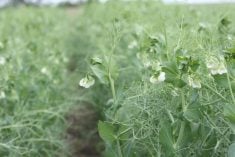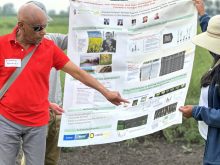Scientists at the University of Missouri-Columbia have furthered the understanding of a communication signal indicating stress in plants.
The research underscores the importance of understanding the mechanisms plants use to build resilience against environmental consequences.
The discovery at UMC involves a group of molecules called reactive oxygen species (ROS), which are produced by all living organisms that use oxygen. They are intrinsic to cell functioning and, in plants, ROS are involved in metabolic processes. However, the research conducted by the scientists on these reactive oxygen species revealed their key roles as a communication signal that can indicate whether plants are stressed, the integration of different stress-response signalling networks, and the activation of plant defence mechanisms and acclimatization.
Read Also

Volunteers help exotic animal farm rebuild
Exotic animal farm loses beloved camel and pony to huge hail storm that gripped the Brooks, Alta. area as a community member starts a fundraiser to help the family recover from the financial and emotional damage.
“I was always interested in the role of ROS in plant stress responses and wanted to develop methods to image ROS, especially since we discovered the ROS wave in plants in 2009,” said Ron Mittler, professor of plant science and technology at UMC’s College of Agriculture.
“The ROS wave is a key stress response mechanism of plants that co-ordinate the responses of different parts of the plants to stress.”
Today, plants can be subject to a variety of stresses all at the same time and much of it is triggered by the consequences of global warming. Mittler said that not only drought, heat waves, cold snaps and floodings cause stress in crops but their potential combinations (flooding and heat, drought and heat) can make stressors worse.
“When stressors from heat and drought are added together, plants don’t have ground water to draw from, so they close the stomata (leaf pores) and this makes the leaves become really hot,” he said. “This is why the combination of drought and heat is really dangerous because the leaf temperature is much higher than with a plant subjected to just heat. The change can be anywhere between two and four degrees and that can make the difference between life and death for the plant.”
He said that, in addition, polluted water resources, air and soil subjected to industrial pollutants such as heavy metals, microplastics and pesticides all subject crop plants to several different stresses.
“At any given time, a plant can be subjected to several different stresses simultaneously or sequentially. This weakens the plant significantly and will cause a reduction in yield and survival. In addition are different pathogens (bacterial, fungal, and viral) and insects, and the changes in the dynamics of their populations driven by climate change can and will attack plants, especially those that are weakened. If it is not bad now, just wait 20 or 30 years.”
Mittler said when a plant is stressed, its metabolism is altered and goes out of balance. This causes an elevated level of ROS production which, he said, is why ROS emerged as such important signalling molecules.
“They are simply an easy cue for the plant that something is wrong and needs adjustment. Once the plant senses the stress due to elevated ROS levels it will adjust its metabolism and reduce the levels of ROS down to baseline levels.”
It is a balancing act. Too much or too little of the ROS factor can be damaging but an optimum level of the molecules can be safe for the plant’s life.
Looking forward, Mittler said that one of the research goals in his lab is to take advantage of ROS responses and increase a plant’s stress tolerance by accumulating more or less ROS under different stress conditions to improve a plant’s tolerance to stress.
Mittler wrote in the report that understanding how ROS orchestrate plant responses to stress will allow scientists to increase plants’ stress tolerance and increase abilities to mitigate crop damage when they are exposed to harsh environmental conditions.
The research was published in Nature Reviews Molecular Cell Biology, a journal of Nature.

















